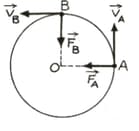HARD
11th ICSE
IMPORTANT
Earn 100
A particle of mass is moving with the uniform speed of in a circular path of radius .
Change in the centripetal force in moving from a to B



Important Questions on Uniform Circular Motion
EASY
11th ICSE
IMPORTANT
MEDIUM
11th ICSE
IMPORTANT
MEDIUM
11th ICSE
IMPORTANT
EASY
11th ICSE
IMPORTANT
EASY
11th ICSE
IMPORTANT
EASY
11th ICSE
IMPORTANT
EASY
11th ICSE
IMPORTANT
EASY
11th ICSE
IMPORTANT
